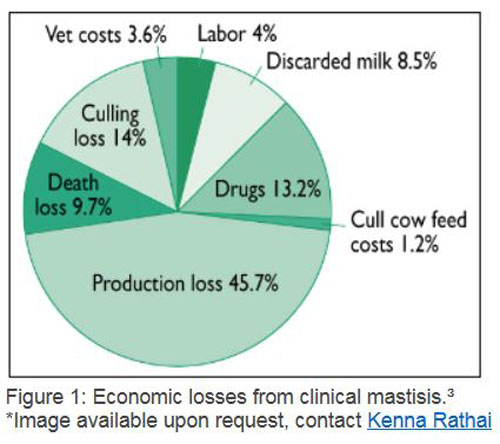
The dairy industry continues its struggle to control coliform mastitis, which was found to be the source of up to 50 percent of mastitis infections on U.S. dairy herds in 2017.¹ The consequences can be devastating, with research indicating a cost of $444 per clinical case of mastitis during the first 30 days in milk.²
Producers can suffer economic losses from clinical mastitis such as added labor, discarded milk, antibiotic treatment, production loss, veterinarian costs, culling and death (see Figure 1).³ In fact, clinical mastitis has been identified as the most common cause of death in adult dairy cows.²
Coliform mastitis infections can arise anytime during a cow’s lactation, but the highest risk period is early to peak lactation. Older, higher-producing cows are especially susceptible. Fortunately, producers can take steps toward prevention and control.
Focus on cleanliness
“Environmental pathogens that cause coliform mastitis can be found anywhere manure comes in contact with the udder,” said Dr. Linda Tikofsky, senior associate director of dairy professional veterinary services, Boehringer Ingelheim. She said producers can minimize mastitis risk by :⁴
- Providing an ample supply of dry, clean bedding that is frequently groomed;
- Refraining from overcrowding and/or overgrazing;
- Managing water tanks, feeding areas and walkways to eliminate standing water or excess manure that might splash onto the udder; and
- Ventilating barns to limit heat stress and the spread of bacteria
Implement a vaccination protocol
Vaccination can help reduce the severity and incidence of coliform mastitis.⁵ “I recommend vaccinating all cows at dry-off, then giving a booster vaccine two to four weeks later,” said Dr. Tikofsky. “If you’re struggling with an outbreak or it’s simply more convenient, you can also vaccinate the entire herd at once. Just don’t forget to give a booster. The vaccine you choose should have a short meat withdrawal and provide protection against E. coli, endotoxemia caused by E. coli and Salmonella Typhimurium. A veterinarian can help create a protocol that is best suited to your operation’s needs.”
Be prepared for an infection
Even with the best practices in place, mastitis infections will still happen. When mild or moderate clinical mastitis cases occur, Dr. Tikofsky recommends taking a milk sample, culturing and waiting 24 hours for results before treating. “Culturing can be done without a negative effect on cure rate or animal welfare in cases of mild or moderate mastitis,” she explained. “If you think you’re experiencing a coliform mastitis outbreak, work with your veterinarian to identify and address the cause.”
About Boehringer Ingelheim
Improving the health and quality of life of patients is the goal of the research-driven pharmaceutical company Boehringer Ingelheim. The focus in doing so is on diseases for which no satisfactory treatment option exists to date. The company therefore concentrates on developing innovative therapies that can extend patients’ lives. In animal health, Boehringer Ingelheim stands for advanced prevention.
Family-owned since it was established in 1885, Boehringer Ingelheim is one of the pharmaceutical industry’s top 20 companies. Some 50,000 employees create value through innovation daily for the three business areas human pharmaceuticals, animal health and biopharmaceuticals. In 2017, Boehringer Ingelheim achieved net sales of nearly 18.1 billion euros. R&D expenditure, exceeding three billion euros, corresponded to 17.0 percent of net sales.
As a family-owned company, Boehringer Ingelheim plans in generations and focuses on long-term success, rather than short-term profit. The company therefore aims at organic growth from its own resources with simultaneous openness to partnerships and strategic alliances in research. In everything it does, Boehringer Ingelheim naturally adopts responsibility towards mankind and the environment.
More information about Boehringer Ingelheim can be found on www.boehringer-ingelheim.com or in our annual report: http://annualreport.boehringer-ingelheim.com/
Boehringer Ingelheim Animal Health Business Unit
Boehringer Ingelheim is the second largest animal health business in the world. We are committed to creating animal well-being through our large portfolio of advanced, preventive healthcare products and services. With net sales of €3.9 billion and around 10,000 employees worldwide, we are present in more than 150 markets. For more information click here.
References:
¹ Continuing market study. Research Department, Hoard’s Dairyman. 2018.
² Rollin E, Dhuyvetter KC, Overton MW. The cost of clinical mastitis in the first 30 days of lactation: An economic modeling tool. Prev Vet Med 2015;122(3):257–264. Available at: https://www.sciencedirect.com/science/article/pii/S0167587715300490#. Accessed July 3, 2018.
³ DeGraves FJ and Fetrow J. Partial budget analysis of vaccinating dairy cattle against coliform mastitis with an Escherichia coli J5 vaccine. J Am Vet Med Assoc 1991;199(4):451–455.
⁴ Quality Milk Production Services, Cornell University, College of Veterinary Medicine. Environmental mastitis. Available at: https://ahdc.vet.cornell.edu/docs/EnvironmentalMastitis.pdf. Accessed July 3, 2018.
⁵ National Mastitis Council. A practical look at environmental mastitis. Available at: http://articles.extension.org/pages/11527/a-practical-look-at-environmental-mastitis. Accessed July 12, 2018.



